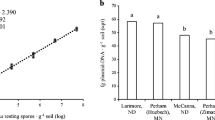Abstract
Pentachloronitrobenzene (PCNB) treatment (20 lb/A – 22.4 kg/ha) showed significant reduction ofRhizoctonia (Rhizoctonia solani Kühn) symptoms on potato. The PCNB treatment increased the number of non-girdled stolons as compared to untreated plots by 50, 34, and 30% at respective seedpiece spacings of 6, 9, and 12 in (15, 23, and 30 cm). Numbers of non-girdled stolons in PCNB-treated plots at 9- and 12-in spacing did not differ significantly from those in untreated plots at 6-in spacing.
Yield differences (either total or U.S. #1) among treatments were not observed, but size differences were evident. Closer spacing or PCNB treatment or both increased the number of small U.S. #1 potatoes and decreased the number of large U.S. #1 potatoes (over 7 oz. - 199 g). Although the number of smaller potatoes was increased by 27% with PCNB treatment, the percentage of malformed tubers was reduced by 50%. Tuber size was reduced as the number of non-girdled stolons was increased (P =.001).
Results suggestthat Rhizoctonia control may benefit the fresh potato packer and seedgrower by potentially reducing seed requirement/acre, by increasing capacity for single-drop seed production, and by greater control over U.S. #1 size.
Resumen
Tratamiento con 22.4 Kg/ha pentacloronitrobenceno (PCNB) resultó en una disminución significativa de los síntomas deRhizoctonia (Rhizoctonia solani Kuhn). Tratamiento con PCNB redujo el número de estolones con lesiones circundantes en comparación con parcelas sin tratar en 50, 34 y 30% con siembras a distancias de 15, 23 y 30 cm, respectivamente. En parcelas tratadas con PCNB con distanciamientos de 23 y 30 cm, el número de estolones sin lesiones circundantes no fue significativamente diferente a parcelas sin tratar con distanciamientos de 15 cm.
No se observaron diferencias en rendimiento (total o de tamaño U.S. #1) entre tratamientos, pero si hubo diferencias evidentes en tamaño de tubérculos. Distanciamiento menor o tratamiento con PCNB, o ambos, incrementaron el número de tubérculos chicos dentro de la clasificación US # 1, disminuyendo el número de los US # 1 grandes (mayores de 199 g). Aunque el número de tubérculos chicos fue incrementado en 27% con tratamiento de PCNB, el porcentaje de tubérculos deformes se redujo en un 50%. El tamaño de los tubérculos disminuyó en relación al incremento de estolones no afectados por lesiones circundantes (P=0.001).
Los resultados sugieren que el control deRhizoctonia puede ser de beneficio al comerciante y productor de semilla por su potencial de reducir las necesidades de semilla/ha, el aumento de la capacidad de producción de semilla en siembra unitaria y por el mayor control sobre tamaño de tubérculos U.S. #1.
Similar content being viewed by others
Literature Cited
Davis, J.R. 1973. Seed and soil treatments for control of rhizoctonia and blackleg of potato. Plant Dis Rep 57: 803–806.
Davis, J.R. 1977. Rhizoctonia disease of potato and its control. Univ of Idaho College of Agric CIS Bull No. 381.
Davis, J.R. 1978. The rhizoctonia disease of potato in Idaho. Am Potato J 55: 58–59.
Davis, J.R. and M.D. Groskopp. 1974. Influence of the rhizoctonia disease and seedpiece spacing on tuber size. Am Potato J (Abstr). 51: 304.
Davis, J.R.,.D. Groskopp, and R.H. Callihan. 1971. Seed and soil treatments for control of rhizoctonia on stems and stolons of potato. Plant Dis Rep 55: 550–554.
Davis, J.R., G.M. McMaster, R.H. Callihan, F.H. Nissley, and J.J. Pavek. 1976. Influence of soil moisture and fungicide treatments on common scab and mineral content of potatoes. Phytopathology 66: 228–233.
Easton, Gene D. 1978. The rhizoctonia disease of potato in Washington. Am Potato J 55: 57–58.
Farley, J.C. and J.L. Lockwood. 1969. Reduced nutrient competition by soil microorganisms as a possible mechanism for pentachloronitrobenzene induced disease accentuation. Phytopathology 59: 718–724.
Frank, James A. 1978. The rhizoctonia disease of potatoes in Maine. Am Potato J 55: 59.
Hooker, W.J. 1978. The rhizoctonia disease of potatoes; description and introductory observations in Michigan. Am Potato J 55: 55–56.
Kreutzer, W.A. 1960. Soil treatment. Vol. III, p. 431–476.In J.G. Horsfall and A.E. Dimond (Ed.) Plant Pathology, an advanced treatise. Academic Press, N.Y.
Kreutzer, W.A. 1963. Selective toxicity of chemicals to soil microorganisms. Annu Rev Phytopathology 1: 101–126.
Weinhold, A.R., Tully Bowman and D.H. Hall. 1978. Rhizoctonia disease of potato in California. Am Potato J 55: 56–57.
Author information
Authors and Affiliations
Additional information
Published with the approval of the Director of the Idaho Agric. Expt. Stn. as Research Paper No. 78719.
Rights and permissions
About this article
Cite this article
Davis, J.R., Groskopp, M.D. Influences of the Rhizoctonia disease on production of the Russet Burbank potato. American Potato Journal 56, 253–264 (1979). https://doi.org/10.1007/BF02854309
Received:
Issue Date:
DOI: https://doi.org/10.1007/BF02854309




